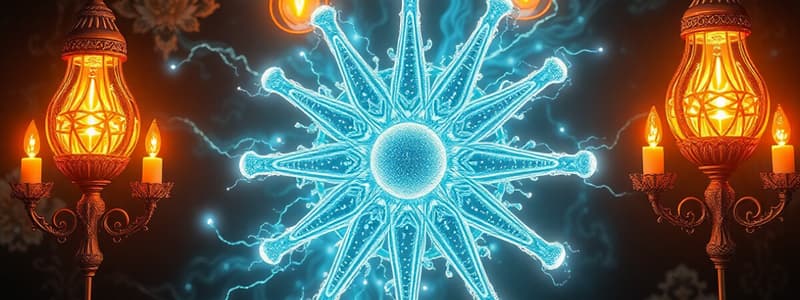Podcast
Questions and Answers
What is the charge of an electron?
What is the charge of an electron?
- 0 C
- +e
- 2e
- -e (correct)
Which of the following correctly describes the behavior of like and unlike charges?
Which of the following correctly describes the behavior of like and unlike charges?
- Like charges attract, unlike charges repel.
- Both like and unlike charges attract each other.
- Both like and unlike charges repel each other.
- Like charges repel, unlike charges attract. (correct)
What happens to the net electric charge during any process in an isolated system?
What happens to the net electric charge during any process in an isolated system?
- It can increase.
- It can decrease.
- It remains constant. (correct)
- It always becomes zero.
Which materials are classified as conductors?
Which materials are classified as conductors?
How do objects become charged?
How do objects become charged?
What is the main reason protons do not move from one material to another?
What is the main reason protons do not move from one material to another?
In an electrically insulated material, what can be said about the movement of electric charges?
In an electrically insulated material, what can be said about the movement of electric charges?
When a conductor is charged in a small region, how does the charge behave?
When a conductor is charged in a small region, how does the charge behave?
What happens to the charge of an insulator when it is rubbed?
What happens to the charge of an insulator when it is rubbed?
Which of the following statements about semiconductors is true?
Which of the following statements about semiconductors is true?
What is the relationship described by Coulomb's Law?
What is the relationship described by Coulomb's Law?
In the example provided, what is the resulting net force on charge q1?
In the example provided, what is the resulting net force on charge q1?
What is the value of the constant k in Coulomb’s Law?
What is the value of the constant k in Coulomb’s Law?
If the distance between two point charges is halved, how does the force between them change according to Coulomb's Law?
If the distance between two point charges is halved, how does the force between them change according to Coulomb's Law?
What is an example of a semiconductor?
What is an example of a semiconductor?
When determining the net force on multiple point charges, what must be considered?
When determining the net force on multiple point charges, what must be considered?
Flashcards are hidden until you start studying
Study Notes
Atomic Structure and Charge
- Electrical properties of matter stem from atomic structure.
- Protons, neutrons, and electrons are the subatomic particles that make up atoms.
- Protons have a positive charge (+e), electrons have a negative charge (-e), and neutrons have no charge.
- The charge of a proton and an electron are equal in magnitude.
- Protons reside in the nucleus of the atom, while electrons orbit the nucleus.
Conservation of Charge
- Charge can neither be created nor destroyed, only transferred.
- The net charge of an isolated system remains constant.
- This means that the total amount of positive charge in the universe remains constant.
Electric Forces
- Like charges repel, and unlike charges attract.
- The force between two charged objects is called the electrostatic force.
- The electrostatic force can be attractive or repulsive, depending on the charges of the objects.
Conductors and Insulators
- Conductors readily allow the movement of electric charge.
- Examples include copper, aluminum, and silver.
- Conductors allow charge to distribute itself evenly.
- Insulators resist the movement of electric charge.
- Examples include glass and rubber.
- Insulators typically retain charge localized in the area where it is applied.
- Semiconductors have properties that fall in between conductors and insulators. Examples include silicon and germanium.
Coulomb's Law
- Coulomb's Law determines the electrostatic force between point charges.
- The magnitude of the force is directly proportional to the product of the charges and inversely proportional to the square of the distance between them.
- Formula: F = k * (q1 * q2) / r^2 ; where F is the force, k is Coulomb's constant (8.99 x 10^9 N.m^2/C^2), q1 and q2 are the charges, and r is the distance between them.
Forces on Charged Particles
- Free body diagrams are useful to visualize the forces acting on a charged particle.
- Net force on a charged particle can be calculated by summing up all the forces acting on it.
Studying That Suits You
Use AI to generate personalized quizzes and flashcards to suit your learning preferences.




